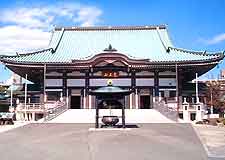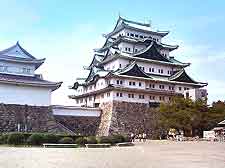Nagoya History Facts and Timeline
(Nagoya, Chubu, Central Honshu, Japan)

Tourists frequently bypass Japan's fourth-most populated city, Nagoya, while headed towards bustling
Tokyo or historic
Kyoto. However, this centrally located city in the middle of Japan's biggest island, Honshu, is certainly worth a closer look.
The city is often compared to
Detroit because of its industrial reputation and numerous car manufacturing plants, but Nagoya's history dates back far longer.
Nagono Manor
The modern metropolis of Nagoya has been constructed on the site of a modest 12th-century manor originally named Nagono. The manor flourished for about two centuries, during which time its pronunciation, and that of the community growing around it, became Nagoya.
Tokugawa Shogunate
In 1603, powerful warlord Oda Nobunaga and two of his proteges achieved their long time goal of uniting Japan under a single government, after their victory at the Battle of Sekigahara. Seven years later, one of Nobunaga's followers, Tokugawa Ieyasu, not only moved Owari's provincial capital from Kiyosu to present-day Nagoya, he forcibly uprooted Kiyosu's entire population of 60,000 to the new provincial capital.
During this time, Ieyasu also built Nagoya Castle for his son, around which the rest of the city would be constructed, using materials from Kiyosu's former castle. Nagoya became an important transportation hub along the Tokaido road between Kyoto and present-day Tokyo. The Tokugawa Shogunate would rule Japan for the next two and a half centuries.

History of the Industrial Era
Nagoya's economic sphere expanded to include the town of Okazaki - among the few locations where gunpowder was made during the Tokugawa Shogunate, and three other surrounding towns famous for their pottery. Complicated 'karakuri ningyo' mechanical dolls became another well-known craft produced here.
In 1868, the Meiji Restoration modernised Japan, restructured its provinces to prefectures, and replaced ruling families with government officials. As a direct result, the Tokugawa Shogunate era came to an end.
Influences of the Second World War
Several years of peace in Nagoya abruptly came to an end during WWII, when the city became a frequent American air raid target. The castle served as a military command post before it was nearly destroyed, along with numerous other buildings, towards the end of the war. The main castle building was completely reconstructed in 1959, the same year the Ise-wan Typhoon caused severe floods throughout the city.
Modern Times in the City
The thriving automobile industry of Nagoya began during the 1930s, when them Toyota Motor Corporation decided to manufacture motorised vehicles instead of looms. Fellow automobile giants Mitsubishi and Honda eventually followed suit, marking a new period in Japanese history.
Many of the city's wide and automobile friendly streets were created from the ruins of WWII. Nagoya's healthy economy has attracted migrants from across Japan and the world. The community of Brazilian immigrants of Japanese descent is especially strong.
 Tourists frequently bypass Japan's fourth-most populated city, Nagoya, while headed towards bustling Tokyo or historic Kyoto. However, this centrally located city in the middle of Japan's biggest island, Honshu, is certainly worth a closer look.
Tourists frequently bypass Japan's fourth-most populated city, Nagoya, while headed towards bustling Tokyo or historic Kyoto. However, this centrally located city in the middle of Japan's biggest island, Honshu, is certainly worth a closer look.